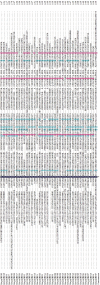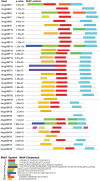Transcriptome analysis used to identify and characterize odorant binding proteins in Agasicles hygrophila (Coleoptera: Chryspmelidae)
- PMID: 37804502
- PMCID: PMC10560004
- DOI: 10.1093/jisesa/iead081
Transcriptome analysis used to identify and characterize odorant binding proteins in Agasicles hygrophila (Coleoptera: Chryspmelidae)
Erratum in
-
Correction to: Transcriptome analysis used to identify and characterize odorant binding proteins in Agasicles hygrophila (Coleoptera: Chrysomelidae).J Insect Sci. 2023 Nov 1;23(6):6. doi: 10.1093/jisesa/iead109. J Insect Sci. 2023. PMID: 38000914 Free PMC article. No abstract available.
Abstract
The transcriptomes of Agasicles hygrophila eggs and first instar larvae were analyzed to explore the olfactory mechanism of larval behavior. The analysis resulted in 135,359 unigenes and the identification of 38 odorant-binding proteins (OBPs), including 23 Minus-C OBPs, 8 Plus-C OBPs, and 7 Classic OBPs. Further analysis of differentially expressed genes (DEGs) revealed 10 DEG OBPs, with 5 (AhygOBP5, AhygOBP9, AhygOBP12, AhygOBP15 and AhygOBP36) up-regulated in first instar larvae. Verification of expression patterns of these 5 AhygOBPs using qPCR showed that AhygOBP9 and AhygOBP36 were mainly expressed in the adult stage with gradually increasing expression in the larval stage. AhygOBP5, AhygOBP12, and AhygOBP15 were not expressed in eggs and pupae, and their expression in larvae and adults showed no clear pattern. These 5 AhygOBPs may play an olfactory role in larval behavior, providing a basis for further investigation of their specific functions and clarifying the olfactory mechanism of A. hygrophila.
Keywords: Agasicles hygrophila; egg; first instar larvae; odorant-binding protein; transcriptome analysis.
© Crown copyright 2023.
Conflict of interest statement
The authors declare that they have no conflict of interest.
Figures





Similar articles
-
Antennal transcriptome analysis of olfactory genes and tissue expression profiling of odorant binding proteins in Semanotus bifasciatus (cerambycidae: coleoptera).BMC Genomics. 2022 Jun 22;23(1):461. doi: 10.1186/s12864-022-08655-w. BMC Genomics. 2022. PMID: 35733103 Free PMC article.
-
The developmental transcriptome of the synanthropic fly Chrysomya megacephala and insights into olfactory proteins.BMC Genomics. 2015 Jan 23;16(1):20. doi: 10.1186/s12864-014-1200-y. BMC Genomics. 2015. PMID: 25612629 Free PMC article.
-
Identification of odorant-binding protein genes in Galeruca daurica (Coleoptera: Chrysomelidae) and analysis of their expression profiles.Bull Entomol Res. 2017 Aug;107(4):550-561. doi: 10.1017/S0007485317000402. Epub 2017 Apr 20. Bull Entomol Res. 2017. PMID: 28424098
-
Transcriptome analysis in different developmental stages of Batocera horsfieldi (Coleoptera: Cerambycidae) and comparison of candidate olfactory genes.PLoS One. 2018 Feb 23;13(2):e0192730. doi: 10.1371/journal.pone.0192730. eCollection 2018. PLoS One. 2018. PMID: 29474419 Free PMC article.
-
Transcriptome analysis and identification of chemosensory genes in the larvae of Plagiodera versicolora.BMC Genomics. 2022 Dec 22;23(1):845. doi: 10.1186/s12864-022-09079-2. BMC Genomics. 2022. PMID: 36544089 Free PMC article.
Cited by
-
Identification and odor exposure regulation of odorant-binding proteins in Picromerus lewisi.Front Physiol. 2024 Dec 4;15:1503440. doi: 10.3389/fphys.2024.1503440. eCollection 2024. Front Physiol. 2024. PMID: 39697614 Free PMC article.
-
Transcriptome sequencing of Antheraea pernyi antennae for identification of olfactory-related genes.BMC Genomics. 2025 May 19;26(1):499. doi: 10.1186/s12864-025-11698-4. BMC Genomics. 2025. PMID: 40383784 Free PMC article.
References
-
- Bruno D, Grossi G, Salvia R, Scala A, Farina D, Grimaldi A, Zhou J-J, Bufo SA, Vogel H, Grosse-Wilde E, et al. . Sensilla morphology and complex expression pattern of odorant binding proteins in the vetch aphid Megoura viciae (Hemiptera: Aphididae). Front Physiol. 2018:9(9):777. 10.3389/fphys.2018.00777 - DOI - PMC - PubMed
-
- Coulson JR. Biological control of Alligatorweed, 1959–1972: a review and evaluation. Tech Bull U S Dep Agric. 1977:1547:98.
-
- Dani FR, Michelucci E, Francese S, Mastrobuoni G, Cappellozza S, La Marca G, Niccolini A, Felicioli A, Moneti G, Pelosi P.. Odorant-binding proteins and chemosensory proteins in pheromone detection and release in the Silkmoth Bombyx mori. Chem Senses. 2011:36(4):335–344. 10.1093/chemse/bjq137 - DOI - PubMed
MeSH terms
Substances
Grants and funding
LinkOut - more resources
Full Text Sources

